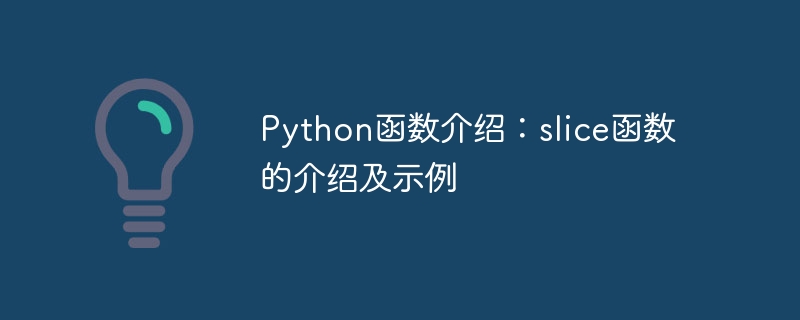

Introduction to Python functions: introduction and examples of slice function
Python is an easy-to-learn, powerful high-level programming language with a rich set of built-in functions and standard libraries . Among them, the slice function is a very practical function in Python, used to create a slice object to cut sequences (including strings, lists, etc.).
The syntax of the slice function is as follows:
slice(stop)
slice(start, stop[, step])
Among them, the parameters accepted by the slice function include start , stop and step. start represents the starting position of the slice, stop represents the end position of the slice (excluding elements at this position), and step represents the step size of the slice.
Next, we will introduce the use of the slice function in detail through some examples.
Example 1: Cutting String
string = "Hello, World!" s = slice(7) result = string[s] print(result) # 输出:Hello,
In the above example, we created a string variable "Hello, World!", and then used the slice function to create a slice object s, starting from The starting position defaults to 0, and the ending position is 7, which means the first 7 characters of the string are cut. Finally, the result is output by printing result. (The result is "Hello, ")
Example 2: Slice list
list = [1, 2, 3, 4, 5, 6, 7, 8, 9, 10] s = slice(2, 8, 2) result = list[s] print(result) # 输出:[3, 5, 7]
In the above example, we created a list variable list, and then used the slice function to create a slice object s, The starting position is 2, the ending position is 8, and the step size is 2, that is, the elements with indexes 2 to 7 in the list are cut, and the step size is 2. Finally, the result is output by printing result. (The result is [3, 5, 7])
Example 3: Slice tuple
tuple = (1, 2, 3, 4, 5, 6, 7, 8, 9, 10) s = slice(1, 9, 3) result = tuple[s] print(result) # 输出:(2, 5, 8)
In the above example, we created a tuple variable tuple and then used the slice function to create A slice object s has a starting position of 1, an ending position of 9, and a step size of 3, that is, the elements with indexes 1 to 8 in the tuple are cut, and the step size is 3. Finally, the result is output by printing result. (The result is (2, 5, 8))
Summary:
Through the above example, we can see the flexibility and simplicity of the slice function. Whether you are cutting sequences such as strings, lists, or tuples, the slice function can be easily implemented. At the same time, you can set the starting position, end position and step size of the slice according to your needs, allowing you to perform more flexible slicing operations on the sequence.
It should be noted that during slicing operation, the end position is an open interval, that is, the element at the end position is not included.
The slice function is a very practical function in Python, which makes cutting sequences simple and efficient. By flexibly setting the starting position, ending position and step size of the slice object, we can perform any cutting operation on the target sequence according to our needs, thereby extracting the required elements or subsequences.
We hope that the above content will be helpful to understand and use the slice function, and at the same time, it will also enable us to further learn and explore the excellent programming language Python.
The above is the detailed content of Introduction to Python functions: introduction and examples of slice function. For more information, please follow other related articles on the PHP Chinese website!




